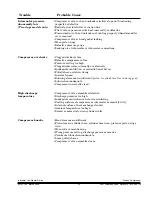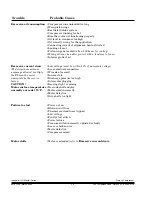
Industrial / Air Master Series
Quincy Compressor
50161-105, March 2008
21
3501 Wismann Lane, Quincy Ill. - 62305-3116
pressure relief valve, pressure gauge, tank drain, & manual shutoff valve (refer
to
Fig. 3-8, Typical Drop Leg & Component Location
).
Follow ASME code for air reciever tanks and other pressure con-
taining vessels. Pressure vessels must not be modified, welded,
repaired, reworked or subjected to operating conditions outside
the nameplate ratings. Such actions will negate code status, affect
insurance status and may cause property damage, severe injury or
even death.
A drain valve should be located in the bottom of the air receiver to allow for
moisture drainage. An automatic drain valve is recommended. Extend piping
away from the unit and any personnel in the immediate area to provide safe and
convenient removal of excess moisture.
If the air receiver is going to be subject to temperatures of 32°F or below,
provisions must be made to guard against freezing of the pressure relief valves,
check valves, pressure gauge, and moisture drain.
Condensation
Rust can form inside the crankcase and on internal components as a result of
condensation. A compressor must operate long enough during each run cycle
to reach full operating temperature in order to reduce the risk of condensation.
Lubricant that appears milky on the dipstick may have mixed with
condensate. Failure to replace contaminated lubricant will result
in damage to the compressor and may void warranty.
Condensation can also form in the air tank of your
compressor. When this happens, a mixture of air and
moisture will be expelled through the service valve and
into whatever is connected to the valve (e.g. air hoses,
metal air lines, pneumatic tools, spray guns). An in-line
filter or dryer, available from your local Quincy dis-
tributor, may be required to eliminate the moisture.
Condensation in the air tank can be kept to a mini-
mum by draining the tank on a daily basis. This also
reduces the risk of rust developing and weakening the
tank.
Manual Tank Drain Valve Operation
The manual tank drain valve on portable compressors and some stationary
compressors is located on the underside of the air tank. Portable compressors
can be tilted in the direction of the drain to allow removal of tank moisture.
Some tanks use an internal drain tube (Refer to
Fig. 3-9, Internal Drain
Tube
) to drain the moisture. Tank pressure is required to force moisture out
of the tank through the drain tube. Safe removal of tank moisture from the air
tank is dependent upon an internal tank pressure of no more than 30 PSIG.
Higher internal tank pressures are dangerous and could cause serious injury!
WARNING !
Pix 1224
Fig. 3-9 Internal Drain Tube
30 PSIG
CAUTION !
Summary of Contents for Air Master Series
Page 46: ......
















































